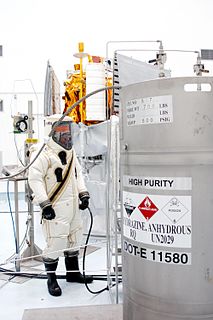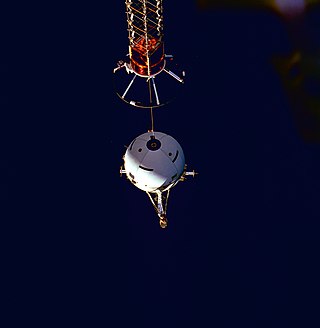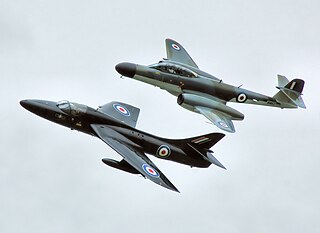This article needs additional citations for verification .(April 2011) (Learn how and when to remove this template message) |
Tethered formation flying is one of applications for space tethers. This sub-set represents an entire area of research using a non-conductive tether to connect multiple spacecraft.

Space tethers are long cables which can be used for propulsion, momentum exchange, stabilization and attitude control, or maintaining the relative positions of the components of a large dispersed satellite/spacecraft sensor system. Depending on the mission objectives and altitude, spaceflight using this form of spacecraft propulsion is theorized to be significantly less expensive than spaceflight using rocket engines.

A spacecraft is a vehicle or machine designed to fly in outer space. Spacecraft are used for a variety of purposes, including communications, earth observation, meteorology, navigation, space colonization, planetary exploration, and transportation of humans and cargo. All spacecraft except single-stage-to-orbit vehicles cannot get into space on their own, and require a launch vehicle.
 |  |
Spacecraft formation flight is becoming a key research area, where distributed computation and decentralized control schemes, as well as information flows between elements, are explored. One such example includes stellar interferometers in which multiple apertures, in controlled formation, collect the light for coherent interferometric beam combinations, thereby achieving a fine angular resolution comparable to a large monolithic aperture telescope. The possible architectures of spaceborne interferometers include a structurally connected interferometer (SCI) Space Interferometry Mission, which allows for very limited baseline changes, and a separated spacecraft interferometer (SSI) Terrestrial Planet Finder, where the usage of propellant can be prohibitively expensive. A tethered-formation flight interferometer represents a balance between SCI and SSI. Such a system is currently being considered for NASA's Submillimeter Probe of the Evolution of Cosmic Structure (SPECS) mission. [1] The dynamics of SSI are coupled by the definition of relative attitude whereas tethered formation spacecraft exhibit inherently coupled nonlinear dynamics.
Angular resolution or spatial resolution describes the ability of any image-forming device such as an optical or radio telescope, a microscope, a camera, or an eye, to distinguish small details of an object, thereby making it a major determinant of image resolution. In physics and geosciences, the term spatial resolution refers to the precision of a measurement with respect to space.

Telescopes are optical instruments that make distant objects appear magnified by using an arrangement of lenses or curved mirrors and lenses, or various devices used to observe distant objects by their emission, absorption, or reflection of electromagnetic radiation. The first known practical telescopes were refracting telescopes invented in the Netherlands at the beginning of the 17th century, by using glass lenses. They found use in both terrestrial applications and astronomy.

The Space Interferometry Mission, or SIM, also known as SIM Lite, was a planned space telescope proposed by the U.S. National Aeronautics and Space Administration (NASA), in conjunction with contractor Northrop Grumman. One of the main goals of the mission was the hunt for Earth-sized planets orbiting in the habitable zones of nearby stars other than the Sun. SIM was postponed several times and finally cancelled in 2010. In addition to detecting extrasolar planets, SIM would have helped astronomers construct a map of the Milky Way galaxy. Other important tasks would have included collecting data to help pinpoint stellar masses for specific types of stars, assisting in the determination of the spatial distribution of dark matter in the Milky Way and in the local group of galaxies and using the gravitational microlensing effect to measure the mass of stars. The spacecraft would have used optical interferometry to accomplish these and other scientific goals.
The MIT Space Systems Laboratory [2] conducted ground experiments that tested a fully decentralized nonlinear control law, which eliminates the need for inter-satellite communications. [3] Contraction theory [4] was used to prove that a nonlinear control law stabilizing a single-tethered spacecraft can also stabilize arbitrarily large circular arrays of tethered spacecraft, as well as a three-spacecraft inline configuration. In order to validate the effectiveness of the decentralized control and estimation framework, a new suite of hardware has been designed and added to the SPHERES (Synchronize Position Hold Engage and Reorient Experimental Satellite) testbed. A 2007 PhD thesis introduced a novel relative attitude estimator, in which a series of Kalman filters incorporate the gyro, force-torque sensor, and relative distance measurements. [5] The closed-loop control experiments can be viewed at [ clarification needed ]. [6] The MIT team also reported the first propellant-free underactuated control results for tethered formation flight. This is motivated by a controllability analysis that indicates that both array resizing and spin-up are fully controllable by the reaction wheels and the tether motor. [7] [8]
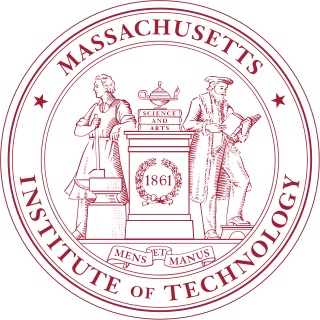
The Massachusetts Institute of Technology (MIT) is a private research university in Cambridge, Massachusetts. Founded in 1861 in response to the increasing industrialization of the United States, MIT adopted a European polytechnic university model and stressed laboratory instruction in applied science and engineering. The institute is traditionally known for its research and education in the physical sciences and engineering, but more recently in biology, economics, linguistics and management as well. MIT is often ranked among the world's top five universities.
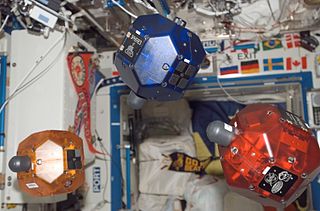
The Synchronized Position Hold Engage and Reorient Experimental Satellite (SPHERES) are a series of miniaturized satellites developed by MIT's Space Systems Laboratory for NASA and US Military, to be used as a low-risk, extensible test bed for the development of metrology, formation flight, rendezvous, docking and autonomy algorithms that are critical for future space missions that use distributed spacecraft architecture, such as Terrestrial Planet Finder and Orbital Express.
